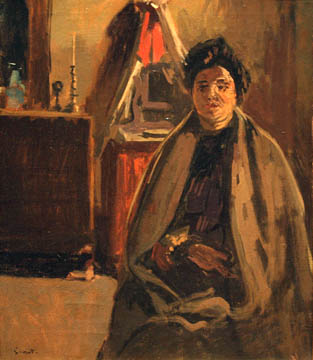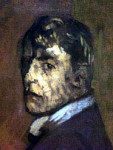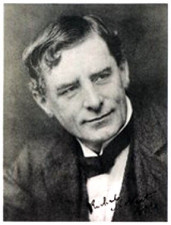
Walter Richard Sickert
British, 1860-1942 (active France)
Donna in Casa: La Carolina Seated in an Interior, 1903-1904
oil on canvas
21 7/8 x 18 1/4 in.
SBMA, Gift of Mary and Will Richeson Jr.
1985.59.2

Sickert in self-portrait
"On a series of apparently tiresome, flat sittings seeming to lead nowhere - one day something happens, the touches seem to 'take', the deaf canvas listens, your words flow and you have done something." - Walter Richard Sickert
RESEARCH PAPER
This acquisition to the Santa Barbara Museum of Art which is an oil on canvas was painted by Walter Sickert in Venice in the winter of 1903 - 1904. The painting was given to the art museum by Mary and Will Richeson, Jr. of Los Angeles, whose gifts also include the two other paintings by Walter Sickert in the museum's collection. Its condition seems good, however there is no background available as to restoration or preservation work which has been done on the painting.
The winter of 1903-1904 was a cold one in Venice and Sickert gave up his more usual subject matter of Venice's architecture and cityscapes to work inside his studio at 940 Calle de Frati. This is one of many paintings and drawings of La Carolina dell'Acqua, who was one of his two favorite models during that winter. Not only does she appear and re-appear in works of this time, but the furniture in the room itself is a constant theme seen over and over again. This repetition was typical of much of the work of his whereby he would paint and re-paint the same composition with some variations.
The composition is very geometric in its form with La Carolina a strong triangular figure in the right foreground. Behind her is the triangular "be-ribboned washstand", an unusual piece of furniture and the rectangular dresser in the left background with its candlestick on one side. The colors are typical of Sickert's painting of interiors at the time: dark and almost murky dull green-brown tones with the arresting contrast of light and red highlights on Carolina's face and shawl and on the washstand. The complexity of the figure and the furniture is conveyed with simple brush strokes, however its simplicity may belie the tedious work put into the painting by Sickert because we know that at this time he had ventured away from the quick alla prima technique of his first master, Whistler, and the Impressionists, and adopted the style of Degas which required studied overpainting. In fact, it is said, that his studios at times resembled assembly lines, he would be working on so many paintings at one time adding a touch here and there to each one and then moving to the next to allow the first one time to dry.
The many works of similar subject matter done in Venice in the winter of 1903-1904 were significant, not only in themselves, but also as the precursors of his most famous later works in which one or two figures are set in a domestic setting in which the figures seem to possess an almost narrative quality. This work is an early exploration into his later themes which became more explicit and renowned during his Camden Town Period.
To understand the work of Walter Richard Sickert without gaining insight into his life and background seems almost impossible. For to a much greater extent than many artists, Sickert was one whose painting was almost totally intertwined into the events of his own long and very full life. He has been called the most important English painter since Turner and there is no question that he remained the pre-eminent English artist throughout his working life. In spite of all these accolades from the artistic community, the general public has not yet granted Sickert the popularity he so richly deserves, possibly because of the difficulty in appreciating some of the characteristics of much of his painting: his often dark and muddy palette, his lack of detail in execution and his continual experimentation into new style and technique.
Although classified as an "English artist", Sickert's actual background and heritage is truly more European. He was born in Munich in 1860, the eldest son of a Danish artist, Oswald Sickert who had become a German citizen through the annexation of Schleswig-Holstein by Prussia in 1868. Sickert's mother was the illegitimate daughter of an eminent English astronomer and an Irish stage entertainer who had been brought up in Dieppe and later in Germany. It was not until after the Prussian annexation that Oswald Sickert moved his family to England, mainly so that his sons would escape conscription into the German army. During his own lifetime, Sickert spent much time in Dieppe as well as Venice, and these escapes abroad further established a more European and less English character to his work. This pot pourri of national heritage, plus his environment in a large, gregarious, active family of six children in which art, music, literature and the stage always played an important role, created the atmosphere in which his genius could flourish.
Following his education, Walter Sickert's first career was as an actor from 1877 to 1881, an interest which never totally left him as evidenced by the immense and outstanding collection of his art work which deals with the theater and specifically scenes from the music halls of England. After a short sojourn at the Slade Art School, he joined Whistler's studio as his student, etching assistant and help-mate. It was on an errand to Paris in 1883 that Sickert first met Degas who proved to be the second great artistic influence in his life. By 1885, when he again met Degas in Dieppe, he was beginning to turn away from some of the teachings of his former master, Whistler, and incorporate the more studied and less spontaneous methods of Degas. It was at this time also that Sickert married his first wife, Ellen Cobden, twelve years his senior and the wealthy daughter of a well known politician. It was during this period that Sickert spent much time in Dieppe during the summers and intermittently with that work, also did the bulk of his paintings and drawings of the English music halls. In 1898, after his divorce from his first wife, he moved to Dieppe and remained there until 1905, when he returned to London, a time interrupted only by a year spent in Venice from 1903 to 1904.
After his return to England, Sickert plunged into a period of work known as his Camden Town Period from the area of London in which he lived -- it was a time of re-discovery for him of his previous interest in the music halls, of a new dimension in both subject matter and exploration of different techniques. It also coincided with his second marriage to Christine Angus and the time of World War I which forced the Sickerts to remain in England and not visit their beloved Dieppe until they returned there permanently in 1919 where Christine died in 1920. The paintings and drawings of this period convey the sadness and loneliness that Sicken was struggling with in his own life. In 1925 Sicken returned to London, engaged himself busily in both teaching and writing again as well as painting and in 1926 married his third wife, Therese Lessore, a longtime friend and fellow artist. Walter Sickert died at the age of 82 in 1942. Sickert's volume of work is immense; his subject matter is extremely varied from wonderful landscapes and architectural scenes to portraits and narratives of life's poignancies, scenes of the theater, drawings, etchings and paintings.
From the three paintings by Sickert presently in the collection of the Santa Barbara Museum of Art it is not possible to grasp the tremendous versatility and range of technique of Walter Sickert. He is an artist who defies classification into any one school or style, but instead was able to experiment and explore on his own, grasping those techniques of other artists which suited his temperament and talent and applying his great diversity and strength to a broad spectrum of work.
Prepared for the Santa Barbara Museum of Art Docent Council by Nyna Mahan April 10, 1986
BIBLIOGRAPHY
BOOKS:
Baron, Wendy. Sickert. London, Phaidon, 1973.
Baron, Wendy. The Camden Town Group. London, Scolar Press, 1979.
Browse, Lillian. Sickert. London, Faber & Faber, 1943.
Browse, Lillian. Sickert. London, Rupert Hart-Davis, 1960.
Dunston, Bernard. Painting Methods of the Impressionists. New York, Watson-Guptill, 1976.
Emmons, Robert. The Life and Opinions of Walter Richard Sicken. London, Faber & Faber, 1941.
Harrison, Charles. English Art and Modernism 1900-1939. Bloomington Indiana University Press, 1981.
Lilly, Marjorie. Sickert; the Painter and His Circle. London, Elek, 1971.
Rothenstein, John. Modern English Painters. London, 1957.
Rothenstein, Sir John. Sickert. London, Beaverbrook Newspapers, 1961.
Shone, Richard Noel. The Century of Change: British Painting Since 1900. Oxford, Phaidon, 1977.
Sitwell, Osbert, Editor. A Free House: Or, the Artist as Craftsman Being the Writings o Water Richard Sickert. London. Macmillan, 1947.
Stephenson, W. H. Sicken: The Man and His Art: Random Reminiscences. Southport. Johnson, 1940.
Sutton, Denys. Sickert; A Biography. London. Michael Joseph, 1976.
Additional list of periodicals and catalogs are available on file in docent office.

Undated photo of Sickert
SBMA CURATORIAL LABELS
Sickert had been familiar with the topography of Venice since his time in Whistler’s studio, making his first visit in 1894. During the ensuing decade, he revisited the city on a number of occasions, focusing on the city’s grand vistas and buildings. However, on his final expedition in 1903-04, the poor weather forced him to paint indoors. So, he employed La Giuseppina and La Carolina dell’ Acqua, Venetian prostitutes, to act as models and proceeded to paint a highly important group of one and two figure subject paintings, free of any narrative. Carolina was known among her clients for her aversion to water, whether for washing or drinking is not documented. This painting comes from an important series that shows La Carolina in various states of undress that one might only witness in an intimate setting behind closed doors. The extremely loose paint handling, as well as choice of subject, is indisputably the result of Sickert’s knowledge of the work of Edgar Degas.
- Ridley-Tree Reopening, 2021
Sickert had been familiar with the topography of Venice since his time in Whistler’s studio, making his first visit in 1894. During the ensuing decade he revisited the city on a number of occasions, focussing on the city’s grand vistas and buildings. However on his final expedition in 1903-04 the poor weather forced him to paint indoors, so he employed two Venetian prostitutes to act as models -- La Giuseppina and Carolina del Acqua -- and proceeded to paint a highly important group of one and two figure subject paintings, but free of any narrative.
- British Modernism Whistler to WWII, 2016
